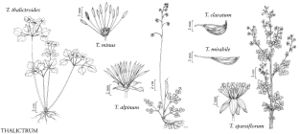Difference between revisions of "Thalictrum minus"
Sp. Pl. 1: 546. 1753.
FNA>Volume Importer |
FNA>Volume Importer |
||
| Line 13: | Line 13: | ||
|basionyms= | |basionyms= | ||
|synonyms={{Treatment/ID/Synonym | |synonyms={{Treatment/ID/Synonym | ||
| − | |name= | + | |name=Thalictrum minus subsp. kemense |
|authority=(Fries) Hultén | |authority=(Fries) Hultén | ||
| − | }}{{Treatment/ID/Synonym | + | }} {{Treatment/ID/Synonym |
| − | |name= | + | |name=Thalictrum minus var. stipellatum |
|authority=(C. A. Meyer) Tamura | |authority=(C. A. Meyer) Tamura | ||
}} | }} | ||
| Line 33: | Line 33: | ||
|elevation=0-300 m | |elevation=0-300 m | ||
|distribution=Alaska;Eurasia. | |distribution=Alaska;Eurasia. | ||
| − | |discussion=<p>Thalictrum minus has been reported from mainland Alaska (E. Hultén 1968); we have been able to confirm its occurrence only in the Aleutian Islands.</p><!-- | + | |discussion=<p><i>Thalictrum minus</i> has been reported from mainland Alaska (E. Hultén 1968); we have been able to confirm its occurrence only in the Aleutian Islands.</p><!-- |
--><p>Initially pendent, the flowers become erect. The beak is 0.75-1 mm, much shorter than the achene, and not fimbriate.</p> | --><p>Initially pendent, the flowers become erect. The beak is 0.75-1 mm, much shorter than the achene, and not fimbriate.</p> | ||
|tables= | |tables= | ||
| Line 47: | Line 47: | ||
|rank=species | |rank=species | ||
|parent rank=section | |parent rank=section | ||
| − | |synonyms= | + | |synonyms=Thalictrum minus subsp. kemense;Thalictrum minus var. stipellatum |
|basionyms= | |basionyms= | ||
|family=Ranunculaceae | |family=Ranunculaceae | ||
| Line 58: | Line 58: | ||
|publication year=1753 | |publication year=1753 | ||
|special status=Selected by author to be illustrated | |special status=Selected by author to be illustrated | ||
| − | |source xml=https://jpend@bitbucket.org/aafc-mbb/fna-data-curation.git/src/ | + | |source xml=https://jpend@bitbucket.org/aafc-mbb/fna-data-curation.git/src/8f726806613d60c220dc4493de13607dd3150896/coarse_grained_fna_xml/V3/V3_478.xml |
|genus=Thalictrum | |genus=Thalictrum | ||
|section=Thalictrum sect. Thalictrum | |section=Thalictrum sect. Thalictrum | ||
Revision as of 18:17, 18 September 2019
Stems erect, nearly cespitose or rhizomatous, 15-150 cm, glabrous or somewhat glandular. Leaves basal, 7-30 cm. Leaf blade 3-4-ternate; leaflets nearly orbiculate or broadly ovate, irregularly 2-3-lobed or margins dentate in distal 1/2, 15-30 mm, surfaces glabrous to glandular. Inflorescences panicles with long branches, many flowered. Flowers: pedicels not recurved in fruit; sepals yellowish green, ovate, 3-4 mm; stamens 10-15; anthers yellowish, 2-3 mm. Achenes 3-15, sessile; body broadly ovoid to narrowly oblong-ovoid, 2.5-4 mm, ± weakly veined.
Phenology: Flowering late spring–summer (Jun–Jul).
Habitat: Steppe meadows, shrub thickets, forest margins, and forest meadows
Elevation: 0-300 m
Distribution

Alaska, Eurasia.
Discussion
Thalictrum minus has been reported from mainland Alaska (E. Hultén 1968); we have been able to confirm its occurrence only in the Aleutian Islands.
Initially pendent, the flowers become erect. The beak is 0.75-1 mm, much shorter than the achene, and not fimbriate.
Selected References
None.
